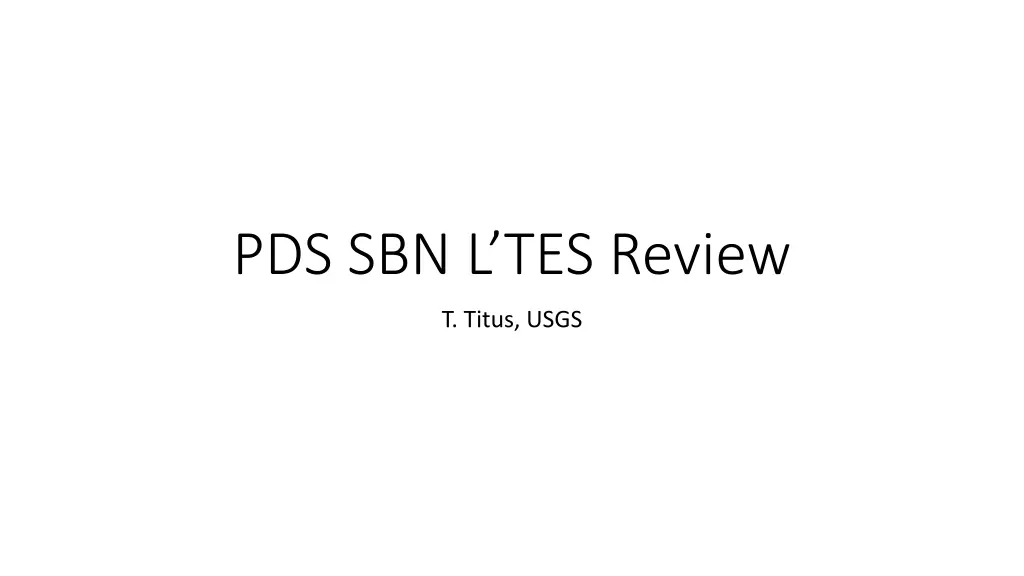
Understanding PDS Labels and Data Quality Assessment
Explore a review of PDS data for the PDS.SBN.LTES.Review.T..Titus dataset, including documentation clarity, PDS labels accuracy, and data quality assessment. Discover insights into data understanding, meta data completeness, and physical reasonability when examining data visually.
Download Presentation

Please find below an Image/Link to download the presentation.
The content on the website is provided AS IS for your information and personal use only. It may not be sold, licensed, or shared on other websites without obtaining consent from the author. If you encounter any issues during the download, it is possible that the publisher has removed the file from their server.
You are allowed to download the files provided on this website for personal or commercial use, subject to the condition that they are used lawfully. All files are the property of their respective owners.
The content on the website is provided AS IS for your information and personal use only. It may not be sold, licensed, or shared on other websites without obtaining consent from the author.
E N D
Presentation Transcript
PDS SBN LTES Review T. Titus, USGS
Documentation Does the dataset contain all documentation needed to use and understand its data without prior knowledge? I believe so. There are some places where the descriptions will need to be improved when calibrated and geometry data becomes available. On page 7, highlight that 6.5 mrad is the FWHM. On page 7, Vicky has a comment about the data having a minimum of 4 locations across the asteroid. Perhaps clarify. Page 8, I find fig2-1 to be a bit confusing. It s the pointing uncertainty always 1/8 of the asteroid s diameter? Won t this vary with distance and size? Alo- is the scan direction going to towards the left? Section 2.3.1 is not very helpful as currently written. Table 2-3 is missing where ENG data falls (or at least its not clear). Table 2-5 must be TBR as there are no volume data shown. The table on Page 25 is either a duplicate or one table is uncalibrated and the other is ENG. I can t tell. Is the provided documentation well organized, clear and self-consistent? Generally, but there are many places labeled TBR. Can the dataset be understood without any external documentation it references, or should the information in said external references be incorporated into the dataset? I think so, at least for the engineering data. Once again, several places are still labeled TBR. If reviewing calibrated data, does the documentation fully explain the calibration process and contain all necessary parameters needed to repeat it? N/A as only the engineering data is readable. o o o
PDS Labels and Meta Data Are the descriptions and scientific content contained inside the PDS labels sufficient to understand their corresponding data products? o Iterferogram is misspelled in labels:description, but not in the ifgm axis_name labels. Is all significant meta data included directly in the PDS labels? o As far as I can tell using the PDS4_Viewer. Do the labels provide all essential description of data values directly in the label, instead of deferring them to external references or documentation? o Generally o Table 3-1 has a label for cmd_fc_echo and cmd_seq_echo but in the meta data cmd is replaced with cal o Table 3-1 index starts at 1 but the PDS4 Label has it starting at 0. Can the data be read programmatically using only the information contained in the PDS labels? o For the ENG data yes. Some of the science data labels are already valid using the PDS4 viewer.
Data Does the data look physically reasonable when examining it by eye or via a display tool? o Yes When displaying the data as plots or images, are there any unexpected deviations? o None that I noticed. Formulate a scientific inquiry and attempt to use the data to answer the inquiry. o Figure 1 (below) shows an interferogram and its FFT inversion. It does resemble what I would expect for a thermal spectrum. It generally looks like a blackbody curve with non-uniform emissivity. If reviewing both raw and calibrated data, attempt to calibrate a raw data file. o N/A






















